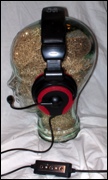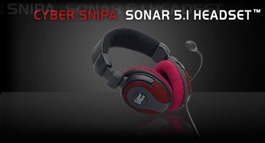|
First Impressions
The left and right earcups were not marked - I assumed the boom was on the left, and later found that it only rotates so it faces forward when worn on the left. Still, this should have been labeled somehow - "minimalist" is not a word you'd use to describe these things, they have no excuse regarding design. Putting them on, the isolation is mediocre - lots of sound leaks in. I'm not sure how much leaks out, but it's generally pretty proportional.
Examining the band - and after passing it around for a fitting test - it may not fit the biggest heads, but makes a valiant attempt. It may not fit the smallest heads, either - clamping pressure was surprisingly low. This, plus the red velvet earcups, mean that extended gaming sessions will be comfortable, but sharp head motions will easily dislodge them if you have a small-to-average head - girl gamers (and there's a lot of them now) may want to keep their receipts. Standard looking around will only make them slide around uncomfortably, but they may slip off with protracted navel-gazing.
 |
 |
 |
The Music Test
Testing on iTunes store, On The Last Day's At the Breaking of the World was pleasantly husky sounding with its wall-of-sound distorted guitars satisfyingly reproduced with surprising kick. But headphones with a lot of base have failed me in the past when subjected to the acid test -- actually the iron test, but that doesn't sound as good -- Bruce Dickinson's operatic solos in an Iron Maiden track. I used the album I had listened to more than any other, Brave New World, and started at the top. Highs were rolled off, as expected; I'll try this again with the equalizer running, but I'm getting a feel for these cans without it first. While they happily reproduce the hum of tube-amplified electric guitar, Dickinson's lyrics are rendered reminiscent of a spoken-word performance. Don't get me wrong, I can see how this would be useful to the target market, who are all about clarity in communication, but I want an adequate exploration of what they are capable of. Fortunately, the Bass Reducer setting (and a little more volume) was enough to replicate the presence-heavy (Presence is the region between midrange and treble) sound of an Iron Maiden album.
Coldplay's Don't Panic was, with Bass Reducer, rendered with truly excellent soundstage, and equally excellent separation of left and right channel binaural audio. Some of the credit must go to the mastering of the track, but it really did feel as though the drums were fifty-five or so degrees off to my left, and the bass guitar equally offset to the right, and the microphone was a foot and a half in front of me. This is the goal that any good sound system strives for - making you feel like you are standing in the recording studio.

The equalizer was deactivated for the next track, Aphex Twin's Windowlicker - this abstract track was once described to me as "zen music meets dance music". Mostly, I use this track and others like it to take potshots at the sounds the headset was capable of rendering, since these incredibly complex compositions are often made up of simple sounds and harmonies combined in complex ways. The ending sounds, meant to reproduce the artist's face in a spectrum analyzer, demonstrate clearly that this set is capable of some impressive highs - but the triple-driver arrangement strongly favors loud (if not jaw-rattlingly deep) low tones. Also in this category, if less firmly, was the work of Brian Transseau, better known as BT, who makes music with mathematically designed harmonies and rhythmic progressions - excellent for spotting weaknesses. BT's Never Gonna Come Back Down didn't sound right until the EQ was set to Electronic, but once set such, I wanted to get up and dance. Speaking of Dance, that EQ setting also sounded marvelous with the same track. I am beginning to get the impression that the triple-driver system allows tremendous flexibility with EQ settings, as compared to single-driver headphones like the Sennheiser HD-280 Pro I used as reference cans. (For the uninitiated, 'cans' is slang for big supra-aural headphones that completely cover the ear.) A few more tracks, and I'll see if I haven't simply discovered the equalizer setting that makes these things sing, or if they really are as flexible as I'm beginning to suspect.
Pink Floyd's symphonic Us and Them album provided needed contrast, and Dance was a bit overbearing. About this point, I noticed significant ear fatigue - the Sennheisers I use as a reference allowed me to go much longer without much un-comfort, despite some of the highest clamping pressure I've ever used - I'm still not sure why, but I'm not willing or able to rule out prejudice - or a random headache. Still, while this is not an audiophile headset, it stood up remarkably well to one that should have been out of its league. And it does something the Sennheiser's $100 pro cans don't - it has a microphone.
OUR OTHER RELEVANT REVIEWS
| Genius HS-04V Headset with Bass Vibration |
| Genius HS-03U Bass Vibration Headset |
| Saitek Cyborg Gaming Headset |
| Razer Barracuda: HP-1 Gaming Headset |




